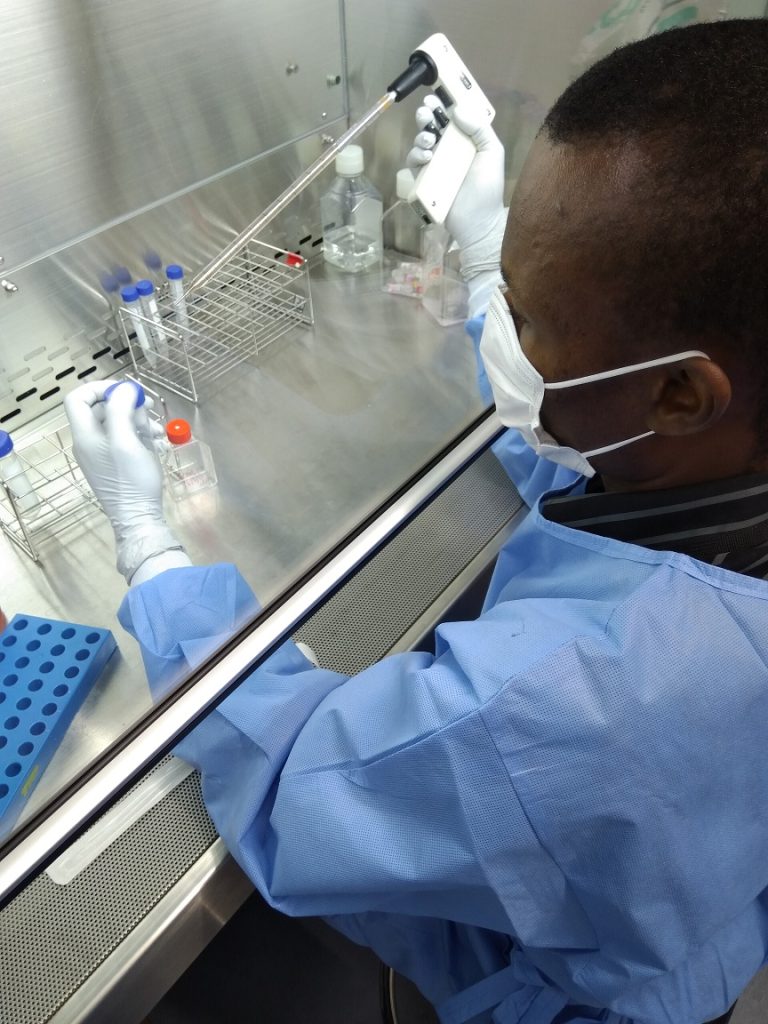Cell culture is the laboratory technique of growing and maintaining the cells of multicellular organisms (plants and animal cells inclusive) in a favourable artificial environment conducive for growth. It is the maintenance of animal cells (inclusive of plant and human cell lines) in vitro.Such an artificial environment or growth medium mimics the internal environment of the organism from which the cell was obtained from; and they support the propagation of the cells to be cultured in vitro. Cell culture is also the removal of cells from an organism (i.e. from their parent tissue) and their subsequent growth in vitro under special controlled growth conditions. This process of removing cells or tissues from their normal in vivo environment (i.e. from their parental host organism) and maintaining their growth in vitro in an artificial growth environment is generally known as explantation. Such cells or tissues are said to be explanted since they now survive outside their host organism.
An explant is simply defined as a fragment of tissue that is transplanted from its original (parental) host organism and maintained in an artificial growth medium in vitro.The survival or viability of cells or tissues outside of their host or parental organism after explantation is critical because once a cell or tissue is explanted from its normal physiological in vivo environment, maintaining its optimal growth in vitro is fundamental to the success of the experimentation. Cell culture technique is also used for the study and cultivation of viruses, protozoa and other obligate intracellular parasites such as Chlamydia and Rickettsia
To ensure viability of the explanted cells or tissues, the in vitro artificial growth environment must be inundated and fashioned with all necessary requirements that mimic the normal in vivo environment from which the cells/tissues was obtained from. There are several environmental factors that must be provided for the successful in vitro cultivation of living cells and tissues outside their physiological in vivo environment. Culture is generally the microbiological laboratory technique in which the growth of microorganisms in a growth medium (solid, liquid or broth) is enhanced for visibility and easy study. Such a medium (which is usually placed in a Petri dish) contains nutritive substances/materials that support the growth of the organisms under certain conditions.
For example, bacteria grow best at 37oC for 18-24 hrs while fungi grow best at 28oC for 18-24 hrs. It is noteworthy that the medium for the growth of a bacterium and fungus varies, and so does the temperature at which they grow. Though cells that can be grown through cell culture can be of prokaryotic or eukaryotic origin, in research the term “cell culture” refers mainly to the culturing of cells that are either of human, microbial, animal or plant origin. The culturing of fungal or bacterial cells must not be mistaken for cell culture. But for the purpose of this topic, the term cell culture and tissue culture shall be used interchangeably.
Cells derived from either animals, humans or plants will continue to grow if supplied with the correct nutrient and environmental conditions necessary for growth to take place. The cultured cells are capable of dividing and increasing in size until their growth is limited by some environmental conditions such as the depletion of growth nutrients. Cell culture encompasses organ culture and other in vitro culture techniques in which cells derived from their parent tissues (as dispersed cells) or from particular cell lines/strains and from primary cell cultures are cultivated in vitro in specialized growth medium that mimic the natural environment from which the cells were initially derived from. Cell culture techniques have several applications.
Cell culture is applied in:
- Tissue engineering,
- Toxicological research,
- Immunological research,
- Proteomics,
- Novel drug discovery
- Pharmacology (especially in drug design), and
- In other advanced molecular biology manipulations.
References
Alberts B, Bray D, Johnson A, Lewis J, Raff M, Roberts K andWalter P (1998). Essential Cell Biology: An Introduction to the Molecular Biology of the Cell. Third edition. Garland Publishing Inc., New York.
Alberts B, Bray D, Lewis J, Raff M, Roberts K and Watson J.D (2002). The molecular Biology of the Cell. Fourth edition. New York, Garland, USA.
Ausubel, F.M., Brent, R., Kingston, R.E., Moore, D.D., Seidman, J.G., Smith, J.A., Struhl, K., eds (2002). Short Protocols in Molecular Biology, 5th edn. John Wiley & Sons, New York.
Caputo J.L (1996). Safety Procedures. In: Freshney, R.I., Freshney, M.G., eds., Culture of Immortalized Cells. New York, Wiley-Liss, Pp. 25-51.
Cooper G.M and Hausman R.E (2004). The cell: A Molecular Approach. Third edition. ASM Press.
Davis J.M (2002). Basic Cell Culture, A Practical Approach. Oxford University Press, Oxford, UK.
Freshney R.I (2005). Culture of Animal Cells, a Manual of Basic Technique, 5th Ed. Hoboken NJ, John Wiley and Sons Publishers.
Health Services Advisory Committee (HSAC) (2003). Safe Working and the Prevention of Infection in Clinical Laboratories. HSE Books: Sudbury
Lodish H, Berk A, Matsudaira P, Kaiser C.A, Kreiger M, Scott M.P, Zipursky S.L and Darnell J (2004). Molecular Cell Biology. Fifth edition. Scientific American Books, Freeman, New York, USA.
Marcovic O and Marcovic N (1998). Cell cross-contamination in cell cultures: the silent and neglected danger. In Vitro Cell Dev Biol. 34:108.
Mather J and Barnes D (1998). Animal cell culture methods, Methods in cell biology. 2rd eds, Academic press, San Diego. Verma P.S and Agarwal V.K (2011). Cytology: Cell Biology and Molecular Biology. Fourth edition. S. Chand and Company Ltd, Ram Nagar, New Delhi, India.
Discover more from #1 Microbiology Resource Hub
Subscribe to get the latest posts to your email.



